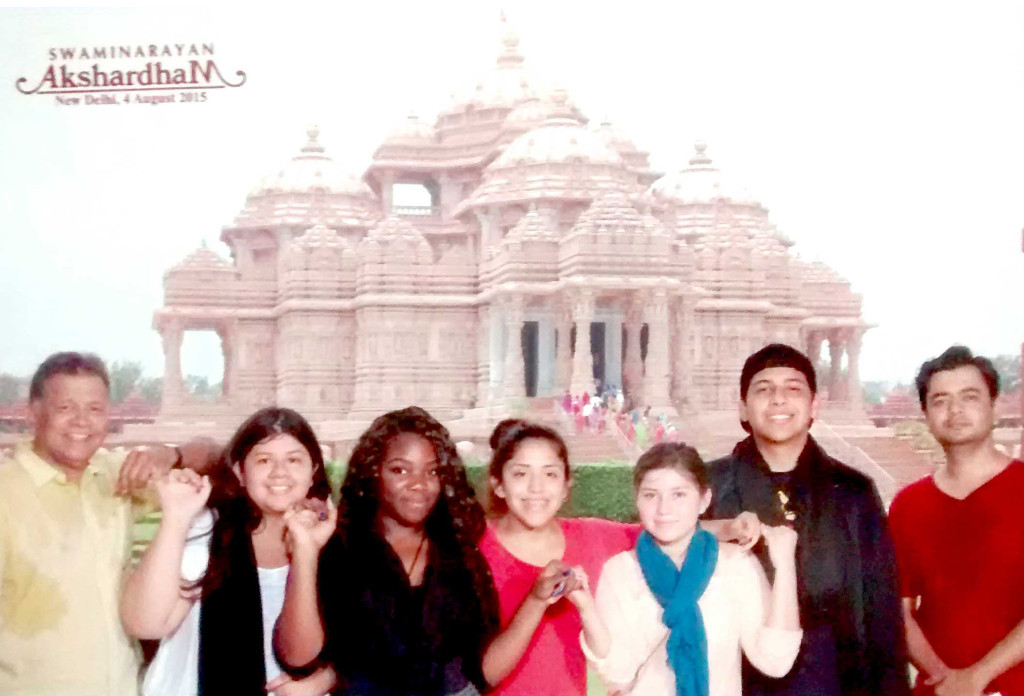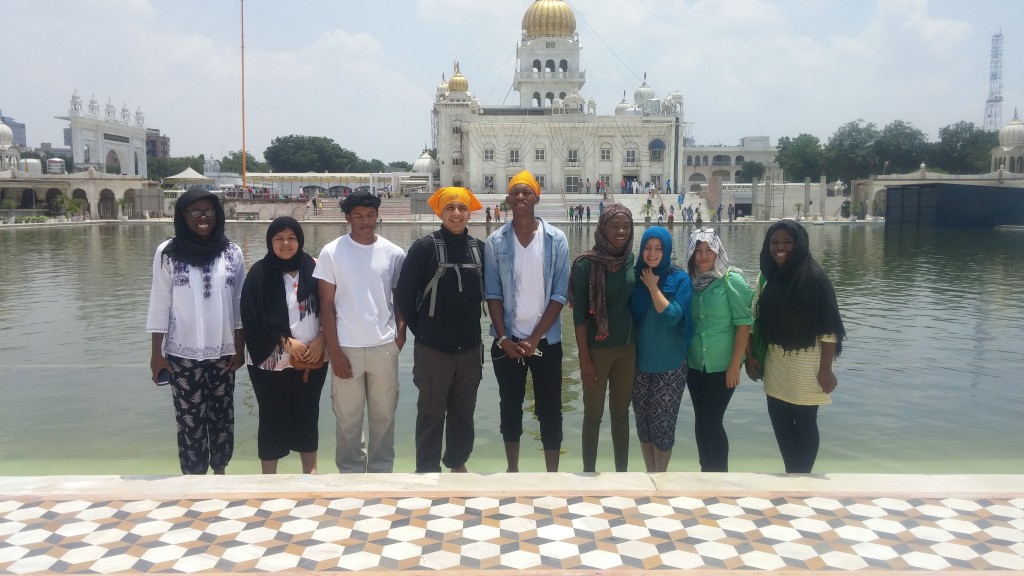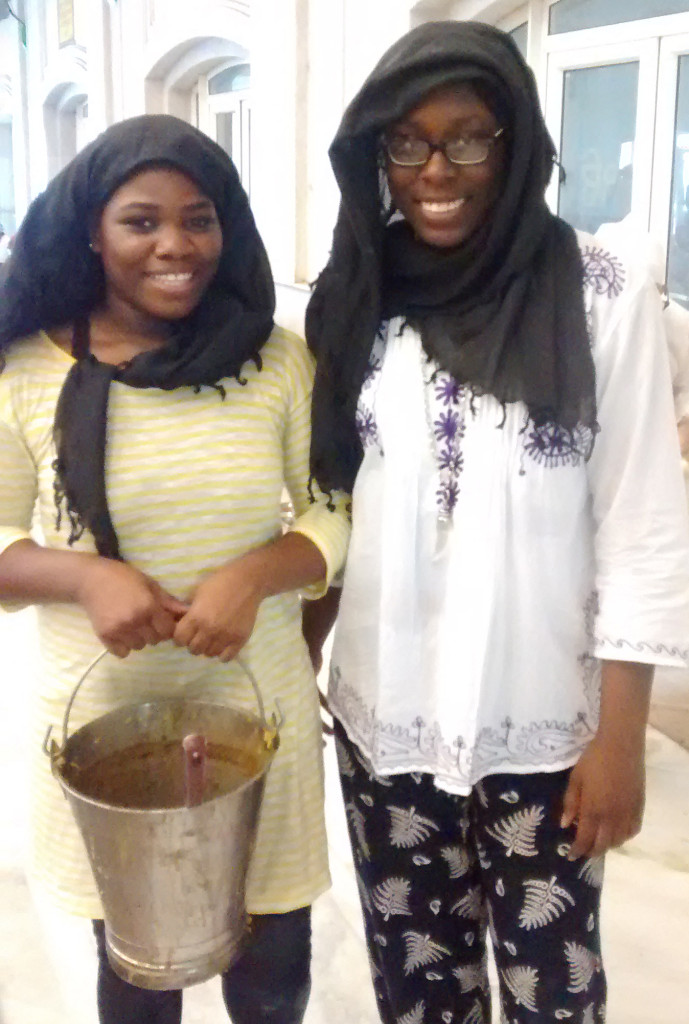After preparing for a couple days before all the students arrived, the South Asian students presented on their cultures for the international students. You can read more here, and see a few student interviews here, beginning with Olga!
Monica
Mohammad
Rohini
Kultwisiso
Shilpi
 Day 3 takes us to Akshardham, a Swaminarayan temple in Delhi, India. Swaminarayan’s follow a sect of Swaminarayan Hinduism, a form of Vaishnavism (or Vishnu worship). Akshardham is set on a 100 acre campus and serves as an education center and temple for India’s Vishnu worshippers and other guests.
Day 3 takes us to Akshardham, a Swaminarayan temple in Delhi, India. Swaminarayan’s follow a sect of Swaminarayan Hinduism, a form of Vaishnavism (or Vishnu worship). Akshardham is set on a 100 acre campus and serves as an education center and temple for India’s Vishnu worshippers and other guests.
Our visit took place on a cloudy, Delhi morning that threatened a downpouring of monsoon rains. Luckily for us, no rains arrived. Akshardham marked the students first introduction to a Hindu temple. The towering domes on the intricately carved marble temple, served as an impressive welcoming to the iconic Hindu temples that dot the country. Inside the temple, we discussed the extravagant display of wealth, including gold plated donation chests, guilded wall carvings, and a gold plated statues of Shree Swaminarayan himself as well as various stories in Hindu mythology.
Post visiting the temple, we moved on to the extensive visitor compound, a maze of fountains, gardens, and history. Inside the visitor compound, we continued to weave our way through a history lesson, demonstrated by way of robotic figurines, on the life and work of Swaminarayan. Post our history lesson, we hopped into a boat for a tour of Indian history. The finale of our day at Akshardham resulted in a sattvic lunch ( no onions, meat, or garlic) at the dining hall.

For many of us, Akshardham provided a fantastic balance to the rush, and heavy questions, which filled Day 2’s visit to the Gurudwara Bangla Sahib and the Jama Masjid. It also brought out an animated conversation during our evening wrap up on the intersection between religion (the Swaminrayan robot tour) and politics ( the Indian history boat tour), that left us all questioning what defines sacred spaces, and if politics can ever healthily be involved in this definition.
Dinner closed with a taste of Indo-Chinese food, and a rousing game of four square as the monsoon rains finally started to fall.
 Monday, our second full day in Delhi, was a day for visiting sacred spaces. We spent some time in the morning preparing for our visits by talking about our own sacred spaces, and then we went to two of the great places of worship in Delhi–the Gurudwara, a Sikh Temple, and the Jama Masjid, the largest Mosque in India. The visit to the Gurudwara in particular made this a very powerful day for our group.
Monday, our second full day in Delhi, was a day for visiting sacred spaces. We spent some time in the morning preparing for our visits by talking about our own sacred spaces, and then we went to two of the great places of worship in Delhi–the Gurudwara, a Sikh Temple, and the Jama Masjid, the largest Mosque in India. The visit to the Gurudwara in particular made this a very powerful day for our group.
 As a tourist, it can be very hard to really connect with people in the country you are visiting. That’s one reason that our visit to the Gurudwara was so special. It gave us the opportunity to connect to people through serving.
As a tourist, it can be very hard to really connect with people in the country you are visiting. That’s one reason that our visit to the Gurudwara was so special. It gave us the opportunity to connect to people through serving.
After taking a tour of the white marble temple and its reflective pool, we went to the kitchen, where volunteers prepare free meals around the clock for over 10,000 people a day. We spent some time rolling and grilling chapatis (Indian whole wheat flatbreads), then we served food to several hundred people in the dining hall, and finally, we took our turn being served. Working side-by-side with other volunteers and waling up and down the rows serving food we crossed the lines that normally separate tourist from native, and we got a glimpse of how Indians see life in Delhi.
 Everyone found his or her niche, whether it was Kyre becoming a master chapati-roller, or grill masters Francisco and Andre, or Selena serving chapatis.
Everyone found his or her niche, whether it was Kyre becoming a master chapati-roller, or grill masters Francisco and Andre, or Selena serving chapatis.
The tour of the temple also struck many of the students, because we had such an engaging guide. He explained that the Sikh religion was about how we learn to work as a team for nature, and not in conflict with it, and how we can anticipate and coordinate with others in order to create a good society. In our evening wrap-up discussion, several students remembered the things the guide had said. A favorite quote was: “If you wish to love God, you must love all his creations equally and serve them, for service is the practical application of divine love.”
 Our guide also taught us the “true” meaning of the princess and the frog, which is that boys are immature and girls need to be wary. (Think about it.)
Our guide also taught us the “true” meaning of the princess and the frog, which is that boys are immature and girls need to be wary. (Think about it.)
 Name: Kadeejisha Walton
Name: Kadeejisha Walton
Hometown: Chicago IL
School: Chicago Military Academy-Bronzeville
Favorite Book: letters to a young brother
Favorite Color: Blue
Give one random fact about you?: I am a fun outgoing outspoken person
If you were a fruit, what would it be?: If I was a fruit I would be a kiwi
What do you think will be surprising about India?: What I think would be surprising is the food
What has been difficult about preparing for India?: What was difficult about preparing for Inda is the passport process
How do you hope to be different after this trip to India?: I hope I get a different perspective of different topics
